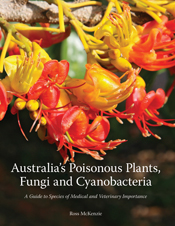
 Australia's Poisonous Plants, Fungi and Cyanobacteria is the first full-colour, comprehensive guide to the major natural threats to health in Australia affecting domestic and native animals and humans. The overriding aim of the book is to prevent poisoning, as there are few effective treatments available, particularly in domestic animals. The species have been chosen because of their capacity to threaten life or damage important organs, their relative abundance or wide distribution in native and naturalised Australian flora, or because of their extensive cultivation as crops, pastures or in gardens. These include flowering plants, ferns and cone-bearing plants, macrofungi, ergot fungi and cyanobacteria. The plant species are grouped by life form such as herbs, grasses and sedges, shrubs, trees, and for flowering plants by flower type and colour for ease of identification. Species described have colour photographs, distribution maps and notes on confusing species, habitats, toxins, animals affected, conditions of poisoning, clinical signs and symptoms, post mortem changes, therapy, prevention and control. Symbols are used for quick reference to poisoning duration and available ways of managing poisoning. As further aids to understanding, poisoning hot-spots are highlighted and the book lists plants under the headings of animals affected and organs affected. A Digest gives brief details for all poisonous species in Australia.
Australia's Poisonous Plants, Fungi and Cyanobacteria is the first full-colour, comprehensive guide to the major natural threats to health in Australia affecting domestic and native animals and humans. The overriding aim of the book is to prevent poisoning, as there are few effective treatments available, particularly in domestic animals. The species have been chosen because of their capacity to threaten life or damage important organs, their relative abundance or wide distribution in native and naturalised Australian flora, or because of their extensive cultivation as crops, pastures or in gardens. These include flowering plants, ferns and cone-bearing plants, macrofungi, ergot fungi and cyanobacteria. The plant species are grouped by life form such as herbs, grasses and sedges, shrubs, trees, and for flowering plants by flower type and colour for ease of identification. Species described have colour photographs, distribution maps and notes on confusing species, habitats, toxins, animals affected, conditions of poisoning, clinical signs and symptoms, post mortem changes, therapy, prevention and control. Symbols are used for quick reference to poisoning duration and available ways of managing poisoning. As further aids to understanding, poisoning hot-spots are highlighted and the book lists plants under the headings of animals affected and organs affected. A Digest gives brief details for all poisonous species in Australia.| About the author Preface: why this book? Acknowledgements Warnings Using this book 1 Understanding plants and plant poisoning 2 How to confirm tentative identifications 3 Common poisoning profiles Part 1 Poisonous cyanobacteria (blue-green algae) 4 Poisonous cyanobacteria (blue-green algae) Part 2 Poisonous fungi 5 Poisonous fungi Part 3 Poisonous vascular plants 6 Poisonous ferns 7 Poisonous cycads 8 Poisonous grasses, sedges and mat-rushes 9 Poisonous grass-trees 10 Poisonous grass-like herbs (iris and lily families) 11 Poisonous forbs (non-grass-like herbs) 12 Poisonous vines (climbing plants and creepers) 13 Poisonous shrubs 14 Poisonous trees 15 Digest of poisonous cyanobacteria, algae, slime moulds, macrofungi and plants in Australia APPENDIX 1: Aids to identifying flowering plants APPENDIX 2: The top killers APPENDIX 3: Poisoning hot-spots APPENDIX 4: Animals and the major species that poison them APPENDIX 5: Body systems affected by the major poisonous species APPENDIX 6: Australian states with major poisonous species Glossary References and further reading Index View the full table of contents. |
| Colour photographs 976 pages, 270 x 210 mm Publisher: CSIRO PUBLISHING |
Hardback - June 2012 ISBN: 9780643092679 - AU $195.00 |
 |
To purchase, visit CSIRO Publishing by clicking here |